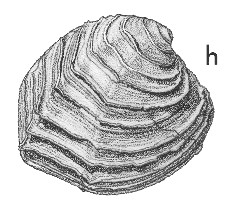
Revised descriptions of New Zealand Cenozoic Mollusca from Beu and Maxwell (1990)

 | Revised descriptions of New Zealand Cenozoic Mollusca from Beu and Maxwell (1990) | 
|
  (Pl. 10h): GS9805, F44/f9501, Coal Brook Station, Wendon Valley, Southland, Duntroonian (GNS) |
Beu & Maxwell (1990): Chapter 10; p. 149; pl. 10 h.
Synonymy: Chione (Liprophora) speighti Suter, 1913b, p. 296; Bassina speighti, Beu & Maxwell, 1990, p. 149, pl. 10h.
Classification: Veneridae: Venerinae
Description: Size moderate for family (length 40-60 mm), broadly ovate, posteriorly truncate, moderately inflated, strongly inequilateral. Two well marked umbonal ridges, one running to posteroventral angle, thus defining a posterior area, the other ending posterior to middle of ventral margin. Anterodorsal margin short, almost straight; posterodorsal margin long, convex; ventral margin obtusely angled. Lunule narrow, but strongly differentiated, broader in right valve than in left. Escutcheon broader and more sharply defined in left than in right valve. Commarginal sculpture of distant, thin lamellae, well preserved shells with crests turned over towards umbones and produced into short triangular spines where they cross the umbonal ridges; interspaces with fine growth lines. Left hinge with a narrow anterior cardinal tooth, a triangular, bifid median cardinal and a narrow, almost horizontal posterior cardinal. Right hinge with a narrow interior cardinal tooth, a narrowly triangular, bifid median cardinal and an equally narrow, weakly bifid posterior cardinal. Pallial sinus moderately deep, triangular. Internal margins finely and weakly crenulate, appearing smooth in many specimens.
Comparison: Circomphalus yatei (Opoitian-Recent) is similar in size to C. speighti but lacks the submedian umbonal ridge and consequently has an evenly convex rather than an obtusely angled ventral margin, although a faint ridge does occur in a few individuals, more visible as spines on the commarginal ridges than as a ridge on the shell surface. C. southlandicus (Opoitian, Te Waewae Bay, Southland) and C. lawsi (Opoitian, Kaawa Creek) also lack the submedian ridge and differ from C. yatei in their smaller size and in outline. C. parvus (Mangapanian-Nukumaruan; Pl. 39e, h) and C. katherinae (Waipipian, Otahuhu; ?Mangapanian, mid-Waipara) retain the submedian ridge (presumably a primitive character for the genus) but differ from C. speighti in their much smaller size and in having more closely spaced commarginal lamellae. B. macclurgi (Nukumaruan, Chatham Island) was based on abbraded specimens of C. yatei, and Bassinaria Marwick, 1928 is a synonym of Circomphalus.
Circomphalus speighti seems to be a good example of "morphological stasis"; during its relatively long period of existence (c. 20 million years) it does not seem to have undergone any significant change in such external features as shape or sculpture, although it must be admitted that internal characters, particularly those of the hinge and pallial sinus, are known for only a few specimens. No other species of Circomphalus are known from New Zealand during this period, but no fewer than three taxa, C. yatei, C. lawsi and C. southlandica, are recorded from the Opoitian and a fourth, C. katherinae is present in the Waipipian-Mangapanian. As with many other New Zealand molluscan genera, speciation seems to have taken place during the Kapitean or earliest Opoitian, probably in response to the marked climatic and eustatic changes during this terminal Miocene to early Pliocene period (see Fleming 1962a). The extant C. yatei inhabits sandy substrates in shallow waters (less than about 40 m), mostly off sandy ocean beaches. C. speighti probably had a similar habitat. Beu (2004, pp. 172-177, fig. 15, 16) showed that Callanaitis Iredale, 1917 (for which the generic name Bassina has generally been used in New Zealand) is a synonym of Circomphalus Mörch, 1853, the type species, C. foliaceolamellosus (Dillwyn, 1817) (Pliocene, S Europe; Pleistocene & Recent, West Africa) being almost indistinguishable from "Bassina" yatei. The interesting point is, then, that this genus seems to have an earlier fossil record in New Zealand than in Europe, and is possibly an initially Southern Hemisphere group that crossed the equator during Miocene or Pliocene time.
Distribution: Duntroonian-Tongaporutuan; Double Corner Shellbeds, Lower Waipara Gorge, Waiauan (type) and numerous localities in both North and South Islands (Fleming 1962, p. 238).
Cite this publication as: "A.G. Beu and J.I. Raine (2009). Revised
descriptions of New Zealand Cenozoic Mollusca from Beu and Maxwell (1990). GNS
Science miscellaneous series no. 27."
© GNS Science, 2009
ISBN
978-0-478-19705-1
ISSN 1177-2441
(Included with a PDF facsimile file
copy of New Zealand Geological Survey Paleontological Bulletin 58 in CD version
from: Publications Officer, GNS Science, P.O. Box 30368 Lower Hutt, New
Zealand)